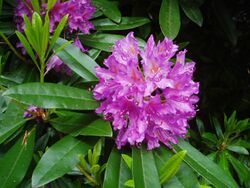Biology:Archaeophyte

An archaeophyte is a plant species which is non-native to a geographical region, but which was an introduced species in "ancient" times, rather than being a modern introduction. Those arriving after are called neophytes.[2]
The cut-off date is usually the beginning of the early modern period (turn of the 15th or 16th century). In Britain, archaeophytes are considered to be those species first introduced prior to the year 1492, when Christopher Columbus arrived in the New World and the Columbian Exchange began.
Background
Archaeophytes include numerous weed species the seeds of which have been found in archaeological excavations - to which they had been brought by people (anthropochory), animals (zoochory) or the wind (anemochory).
In some cases, introduced species, whether archaeophytes or neophytes, may have been native species before the ice ages, which extirpated vast numbers of plant species.[3][4] Central European archaeophytes almost all come from the Mediterranean region and the neighboring areas of Western Asia, as they were introduced into Central Europe with the beginning of agriculture and increasingly since Roman times. They therefore include many familiar plants such as cultivated apples, pears, plums, cereals such as wheat and barley as well as flowers and medicinal plants such as poppy, cornflower, real chamomile and corn.
Australia's collision with the Eurasian Plate led to additional South-east Asian plants entering the Australian flora like the Lepidium and Chenopodioideae.[5] Moreover, Aboriginal Australian and New Guinean contact prior to rising sea levels that isolated Australia from New Guinea in the early Holocene may explain the presence of New Guinea domesticates such as taro (Colocasia esculenta) and bananas (Musa acuminata) in northern Australia. Assisted migrations may also be the reason why some rainforest plants from New Guinea entered northern Australia more than 10,000 years ago.[6]
Examples
Archaeophytes are often cultivated species, transported deliberately by humans, but are also often weeds of cultivation, spread accidentally with grain. Archaeophytes in the United Kingdom include sweet chestnut, wheat, field poppy, flixweed, red valerian, ground elders, soapwort, small toadflax, good king henry and cornflower.[7]
Other examples include:
- Agrostemma githago
- Avena fatua
- Chenopodium polyspermum
- Euphorbia helioscopia
- Setaria viridis
- Vicia hirsuta
- Galium tricornutum
See also
- Biogeography
- Chorology
- Glossary of invasion biology terms
- Introduced species
- Invasive species
- List of invasive species
- Hemerochory
- Adventive plant
References
- ↑ Veröffentlichungen des Tiroler Landesmuseums Ferdinandeum - Rhododendron ponticum L. var. sebinense (SORDELLI) SORDELLI in the Late Pleistocene flora of Hötting, Northern Calcareous Alps: witness of a climate warmer than today?
- ↑ Preston, Christopher D.; Pearman, David A.; Hall, Allan R. (1 July 2004). "Archaeophytes in Britain" (in en). Botanical Journal of the Linnean Society 145 (3): 257–294. doi:10.1111/j.1095-8339.2004.00284.x. ISSN 0024-4074.
- ↑ The Impact of History
- ↑ WLGF - What is the relative value for wildlife of native and non-native plants in our gardens?
- ↑ Crisp, M. (2004). "Radiation of the Australian flora: what can comparisons of molecular phylogenies across multiple taxa tell us about the evolution of diversity in present-day communities?". Philosophical Transactions of the Royal Society of London B: Biological Sciences 359 (1450): 1551–1571. doi:10.1098/rstb.2004.1528. PMID 15519972.
- ↑ Jones, R., and B. Meehan. 1989. Plant Foods of the Gidjingali: Ethnographic and Archaeological Perspectives from Northern Australia on Tuber and Seed Exploitation. In Foraging and Farming: The Evolution of Plant Exploitation , edited by G. R. Harris and G. C. Hillman, pp. 120–135. Unwin Hyman, London.
- ↑ Botanical Journal of the Linnean Society - Archaeophytes in Britain
 |

